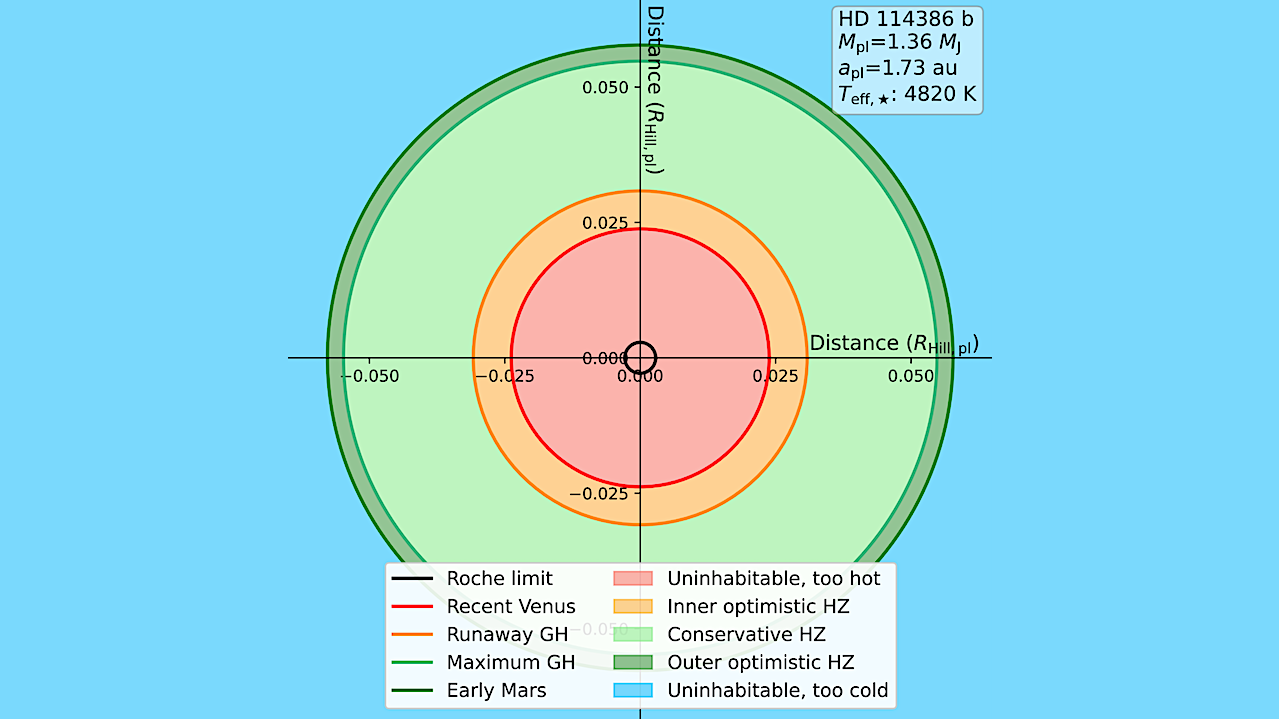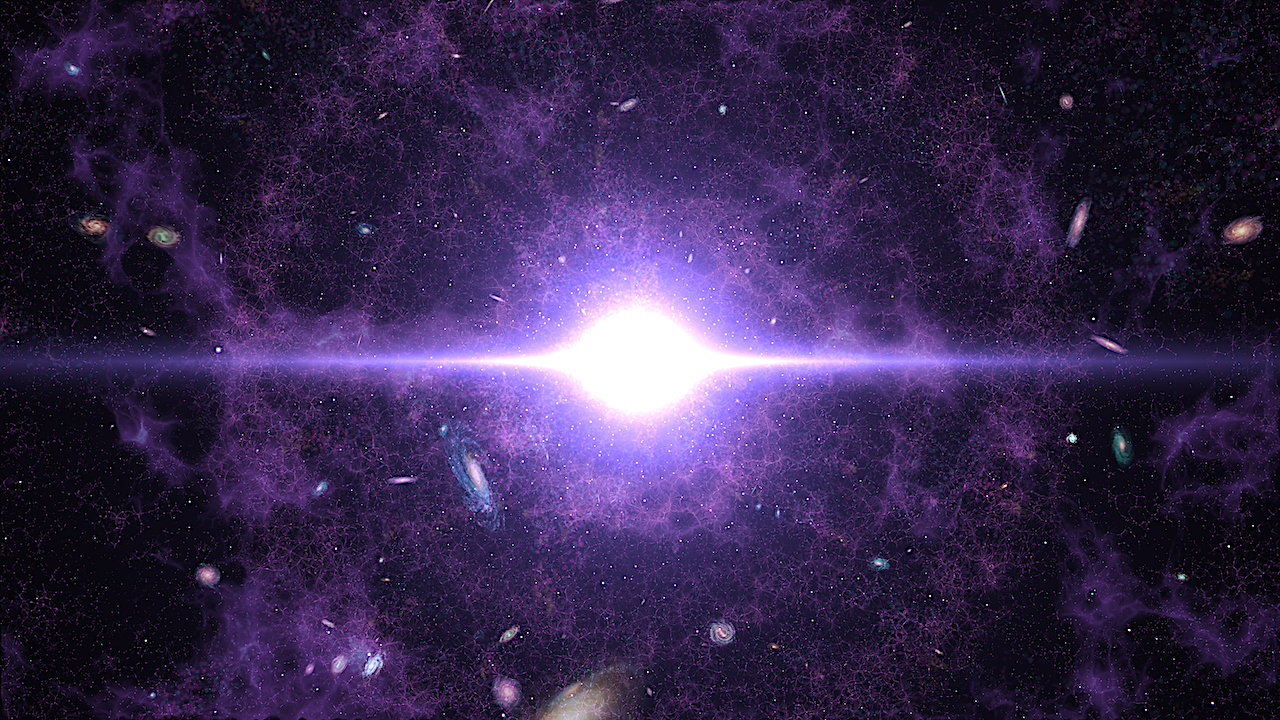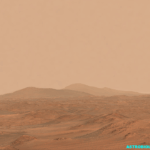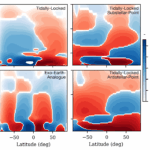Now Reading: Formation Of Habitable Moons Around Giant Planets
-
01
Formation Of Habitable Moons Around Giant Planets
Formation Of Habitable Moons Around Giant Planets


Face-on view of the circumplanetary habitable zone of HD 114386 b assuming an Earth analog moon on e = 0.05 orbit around the planet. The axes represent the distance from the host planet in the planetary Hill radius. Roche (black), recent Venus (red), runaway greenhouse (orange), maximum greenhouse (light green), and early Mars (green) limits are displayed with solid circles. The shaded zones are too hot region for habitability (red), inner optimistic habitable zone (orange), conservative habitable zone (light green), outer optimistic habitable zone (green), and too cold region for habitability (blue). — astro-ph.EP
Of the few thousand discovered exoplanets, a significant number orbit in the habitable zone of their star.
Many of them are gas giants lacking a rocky surface and solid water reservoirs necessary for life as we know it. The search for habitable environments may extend to the moons of these giant planets. No confirmed exomoon discoveries have been made as of today, but promising candidates are known.
Theories suggest that moon formation is a natural process in planetary systems. We aim to study moon formation around giant planets in a phase similar to the final assembly of planet formation. We search for conditions for forming the largest moons with the highest possibility in circumplanetary disks, and investigate whether the resulting moons can be habitable.
We determined the fraction of the circumplanetary disk’s mass converted into moons using numerical N-body simulations where moon embryos grow via embryo-satellitesimal collisions, investigated in disks around giant planets consisting of 100 fully interacting embryos and 1000 satellitesimals. In fiducial simulations, a 10 Jupiter-mass planet orbited a solar analog star at distances of 1-5 au.
To determine the habitability of the synthetic moons, we calculated the stellar irradiation and tidal heating flux on these moons based on their orbital and physical parameters. The individual moon mass is found to be higher when the host planet orbits at a smaller stellar distance.
However, moons leave the circumplanetary disk due to the stellar thief effect, which is stronger closer to the star. We find that 32% of synthetic moons can be habitable in the circumstellar habitable zone. Due to the intense tidal heating, the incidence rate of moon habitability is similar at 2 au, and decreasing to 1% at larger distances (<5 au). We conclude that the circumstellar habitable zone can be extended to moons around giant planets.

Stellar luminosity as a function of the semi-major axis of 1MJ < Mpl < 13 MJ exoplanet orbits derived from exoplanets.org. The limits of the circumstellar habitable zone (CSHZ) are displayed with curves: recent Venus (dashed red), runaway greenhouse (solid red), maximum greenhouse (solid blue), and early Mars (dashed blue) based on Kopparapu et al. (2014). Planets are represented as colored dots whose size is proportional to M 1/3 pl . Red and blue dots represent planets that cannot host a habitable environment for Earth analog moons (they are too hot or too cold, respectively). Orange, light green and dark green colors show that the putative moon experiences enough energy to be considered habitable. The date of the exoplanets.org query is May 2024. We note that the purpose of the data are merely to demonstrate, using a sample of planets, that our method is valid. It is not intended to assess habitability for the most recently discovered planets. — astro-ph.EP
Zoltan Dencs, Vera Dobos, Zsolt Regaly
Comments: Accepted for publication by A&A. 12 pages, 7 figures, 3 tables
Subjects: Earth and Planetary Astrophysics (astro-ph.EP)
Cite as: arXiv:2505.18144 [astro-ph.EP] (or arXiv:2505.18144v1 [astro-ph.EP] for this version)
https://doi.org/10.48550/arXiv.2505.18144
Focus to learn more
Submission history
From: Zoltan Dencs
[v1] Fri, 23 May 2025 17:54:44 UTC (4,815 KB)
https://arxiv.org/abs/2505.18144
Astrobiology
Stay Informed With the Latest & Most Important News
-
 01From Polymerization-Enabled Folding and Assembly to Chemical Evolution: Key Processes for Emergence of Functional Polymers in the Origin of Life
01From Polymerization-Enabled Folding and Assembly to Chemical Evolution: Key Processes for Emergence of Functional Polymers in the Origin of Life -
 02Panasonic Leica Summilux DG 15mm f/1.7 ASPH review
02Panasonic Leica Summilux DG 15mm f/1.7 ASPH review -
 03How New NASA, India Earth Satellite NISAR Will See Earth
03How New NASA, India Earth Satellite NISAR Will See Earth -
 04And Thus Begins A New Year For Life On Earth
04And Thus Begins A New Year For Life On Earth -
 05Astronomy Activation Ambassadors: A New Era
05Astronomy Activation Ambassadors: A New Era -
06SpaceX launch surge helps set new global launch record in 2024
-
 07Space Force plans new ‘Futures Command’ amid pressure to speed up modernization
07Space Force plans new ‘Futures Command’ amid pressure to speed up modernization




















